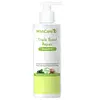What's inside
What's inside
 Key Ingredients
Key Ingredients

 Benefits
Benefits

 Concerns
Concerns

 Ingredients Side-by-side
Ingredients Side-by-side

Water
Skin ConditioningSodium C12-13 Pareth Sulfate
CleansingCocamidopropyl Betaine
CleansingSodium Gluconate
Skin ConditioningSodium Chloride
MaskingDimethiconol
EmollientParfum
MaskingCitric Acid
BufferingSodium Benzoate
MaskingGlycerin
HumectantGlycol Distearate
EmollientCarbomer
Emulsion StabilisingSodium Laureth Sulfate
CleansingGuar Hydroxypropyltrimonium Chloride
Skin ConditioningTea-Dodecylbenzenesulfonate
CleansingPPG-9
Skin ConditioningCocamide Mea
EmulsifyingDisodium EDTA
PEG-45m
HumectantVitis Vinifera Seed Oil
EmollientCocos Nucifera Oil
MaskingHydrolyzed Soy Protein
HumectantAlpha-Isomethyl Ionone
PerfumingCitronellol
PerfumingCoumarin
PerfumingGeraniol
PerfumingLinalool
PerfumingCI 19140
Cosmetic ColorantCI 17200
Cosmetic ColorantMica
Cosmetic ColorantCI 77891
Cosmetic ColorantWater, Sodium C12-13 Pareth Sulfate, Cocamidopropyl Betaine, Sodium Gluconate, Sodium Chloride, Dimethiconol, Parfum, Citric Acid, Sodium Benzoate, Glycerin, Glycol Distearate, Carbomer, Sodium Laureth Sulfate, Guar Hydroxypropyltrimonium Chloride, Tea-Dodecylbenzenesulfonate, PPG-9, Cocamide Mea, Disodium EDTA, PEG-45m, Vitis Vinifera Seed Oil, Cocos Nucifera Oil, Hydrolyzed Soy Protein, Alpha-Isomethyl Ionone, Citronellol, Coumarin, Geraniol, Linalool, CI 19140, CI 17200, Mica, CI 77891
Water
Skin ConditioningSodium Lauroyl Sarcosinate
CleansingCocamidopropyl Betaine
CleansingSodium Cocoyl Isethionate
CleansingDecyl Glucoside
CleansingGluconamido Amodimethicone
PEG-8 Amodimethicone
Glycol Stearate
EmollientPEG-150 Distearate
EmulsifyingGlycerin
HumectantDimethiconol
EmollientTea-Dodecylbenzenesulfonate
CleansingPhenoxyethanol
PreservativeSodium PCA
HumectantSodium Benzoate
MaskingPolyquaternium-10
Guar Hydroxypropyltrimonium Chloride
Skin ConditioningSodium Gluconate
Skin ConditioningArginine
MaskingHydrolyzed Keratin
HumectantHydrolyzed Collagen
EmollientHydrolyzed Wheat Protein
Skin ConditioningPanthenol
Skin ConditioningLactic Acid
BufferingCeramide AP
Skin ConditioningOligopeptide-2
Skin ConditioningBrassica Oleracea Acephala Leaf Extract
HumectantWater, Sodium Lauroyl Sarcosinate, Cocamidopropyl Betaine, Sodium Cocoyl Isethionate, Decyl Glucoside, Gluconamido Amodimethicone, PEG-8 Amodimethicone, Glycol Stearate, PEG-150 Distearate, Glycerin, Dimethiconol, Tea-Dodecylbenzenesulfonate, Phenoxyethanol, Sodium PCA, Sodium Benzoate, Polyquaternium-10, Guar Hydroxypropyltrimonium Chloride, Sodium Gluconate, Arginine, Hydrolyzed Keratin, Hydrolyzed Collagen, Hydrolyzed Wheat Protein, Panthenol, Lactic Acid, Ceramide AP, Oligopeptide-2, Brassica Oleracea Acephala Leaf Extract
Ingredients Explained
These ingredients are found in both products.
Ingredients higher up in an ingredient list are typically present in a larger amount.
Cocamidopropyl Betaine is a fatty acid created by mixing similar compounds in coconut oil and dimethylaminopropylamine, a compound with two amino groups.
This ingredient is a surfactant and cleanser. It helps gather the dirt, pollutants, and other impurities in your skin to be washed away. It also helps thicken a product and make the texture more creamy.
Being created from coconut oil means Cocamidopropyl Betaine is hydrating for the skin.
While Cocamidopropyl Betaine was believed to be an allergen, a study from 2012 disproved this. It found two compounds in unpure Cocamidopropyl Betaine to be the irritants: aminoamide and 3-dimethylaminopropylamine. High-grade and pure Cocamidopropyl Betaine did not induce allergic reactions during this study.
Learn more about Cocamidopropyl BetaineDimethiconol is a silicone that resembles the popular dimethicone. Like other silicones, it is an emollient. Emollients create a thin film on skin to prevent moisture from escaping.
This ingredient helps to create a silky texture and improve spreadability. Due to its high molecular weight and thickness, it is often combined with cyclopentasiloxane.
Glycerin is already naturally found in your skin. It helps moisturize and protect your skin.
A study from 2016 found glycerin to be more effective as a humectant than AHAs and hyaluronic acid.
As a humectant, it helps the skin stay hydrated by pulling moisture to your skin. The low molecular weight of glycerin allows it to pull moisture into the deeper layers of your skin.
Hydrated skin improves your skin barrier; Your skin barrier helps protect against irritants and bacteria.
Glycerin has also been found to have antimicrobial and antiviral properties. Due to these properties, glycerin is often used in wound and burn treatments.
In cosmetics, glycerin is usually derived from plants such as soybean or palm. However, it can also be sourced from animals, such as tallow or animal fat.
This ingredient is organic, colorless, odorless, and non-toxic.
Glycerin is the name for this ingredient in American English. British English uses Glycerol/Glycerine.
Learn more about GlycerinThis ingredient is derived from guar gum.
It is a conditioning ingredient, meaning it helps soften skin and hair.
Sodium Benzoate is a preservative. It's used in both cosmetic and food products to inhibit the growth of mold and bacteria. It is typically produced synthetically.
Both the US FDA and EU Health Committee have approved the use of sodium benzoate. In the US, levels of 0.1% (of the total product) are allowed.
Sodium benzoate works as a preservative by inhibiting the growth of bacteria inside of cells. It prevents the cell from fermenting a type of sugar using an enzyme called phosphofructokinase.
It is the salt of benzoic acid. Foods containing sodium benzoate include soda, salad dressings, condiments, fruit juices, wines, and snack foods.
Studies for using ascorbic acid and sodium benzoate in cosmetics are lacking, especially in skincare routines with multiple steps.
We always recommend speaking with a professional, such as a dermatologist, if you have any concerns.
Learn more about Sodium BenzoateThis is the synthetic salt of gluconic acid, a form of PHA and mild exfoliant.
It is mainly used to stabilize oil and butter formulations from going bad. Sodium gluconate is a humectant, pH regulator, and chelating agent.
Chelating agents help neutralize unwanted metals from affecting the formulation.
Sodium gluconate is water-soluble.
Learn more about Sodium GluconateWe don't have a description for Tea-Dodecylbenzenesulfonate yet.
Water. It's the most common cosmetic ingredient of all. You'll usually see it at the top of ingredient lists, meaning that it makes up the largest part of the product.
So why is it so popular? Water most often acts as a solvent - this means that it helps dissolve other ingredients into the formulation.
You'll also recognize water as that liquid we all need to stay alive. If you see this, drink a glass of water. Stay hydrated!
Learn more about Water